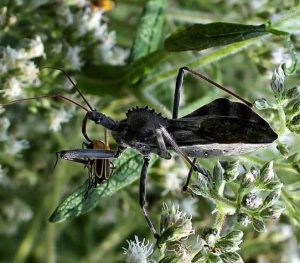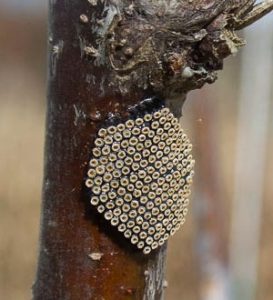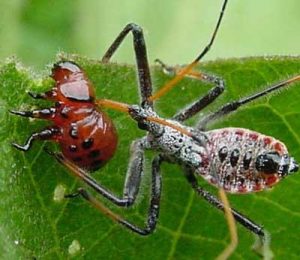Friend or Foe?
Assassin Bugs

Assassin bug feeding on soldier beetle
Assassin bugs are in the order Hemiptera, which include, among many others, leaf-footed bugs and stink bugs. Like all species in this order, they have piercing and sucking mouthparts, but unlike most others in the order, they have three-segmented beaks, which are held curved under their bodies. They have long, narrow bodies and long, narrow heads and can be colorful or camouflaged. Assassin bugs have a simple metamorphosis consisting of egg, nymph (which molts four to seven times) and adult. The eggs are barrel-shaped and tightly compacted together, in clusters from 10 to 40 per cluster. Most species overwinter in egg form, and nymphs are first seen hunting in May or June. They can fly but most are very weak fliers. Most are 1/2 inch to 3/4 inch long, but some can be up to 1-3/4 inch long.

Assassin bug egg mass in hexagonal configuration
The role of assassin bugs as aggressive predators in the landscape is significant. They feed on a wide variety of pests including caterpillars (e.g. gypsy moth, eastern tent caterpillars, cankerworms, fall webworm), plant hoppers, sawfly larvae, aphids and beetles and their larvae (including Japanese beetles). They are welcomed as one of the limited number of predators of the brown marmorated stink bug.

Assassin feeding on Colorado potato beetle larva
There are as many as 50 different species of assassin bug in Virginia, with quite variable appearances, but all are identifiable by the characteristic beak. One of the most commonly found in our area is the wheel bug (Arilus cristatus), which is also our largest at 1 inch to 1 ½ inch. Its life cycle is typical to that of the other assassin bugs. It gets its name from the prominent bump on its back that resembles a cogged wheel. Their red and black nymphs can be mistaken for pests such as aphids in late spring and sometimes may be brought to a plant clinic for identification.
As mentioned above, assassin bugs use venom to paralyze their prey. This tiny amount of venom is what makes their human bites so painful. However, assassin bugs only bite humans when provoked. Their voracious predation of many of our garden pests make them a friend, not a foe.
References
• Assassin Bugs: A Generalist Predatory Bug, Paula Shrewsbury, University of Maryland Extension, College of
Agriculture and Natural Resources
• Small Beaked Wonder, Steve Allgeier, University of Maryland Extension, College of Agriculture and
Natural Resources
• Assassin Bug, Debbie Roos, NC State Extension
• Assassin Bugs and Ambush Bugs, Blake Newton, University of Kentucky Entomolog
• Wheel Bug Stalks Caterpillar, Michael Raupp, Bug of the Week, University of Maryland (video)